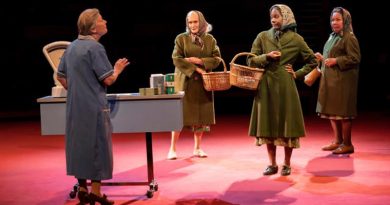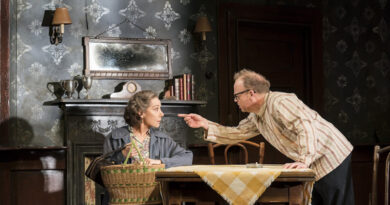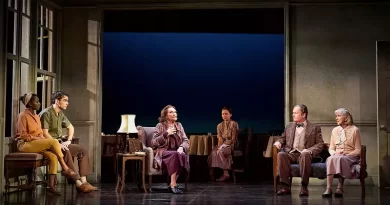“Art” at Devonshire Park Theatre, Eastbourne
Jeremy Malies in East Sussex
10 October 2024
Director Iqbal Khan has reinvigorated Art by Yasmina Reza. I wonder how the French playwright acquired her knowledge of the precise way in which men argue and bond. She is a phenomenon, and even this knowledge on its own would not enable you to write a play that has won Olivier, Tony, and Molière awards as well as being translated into 30 languages.
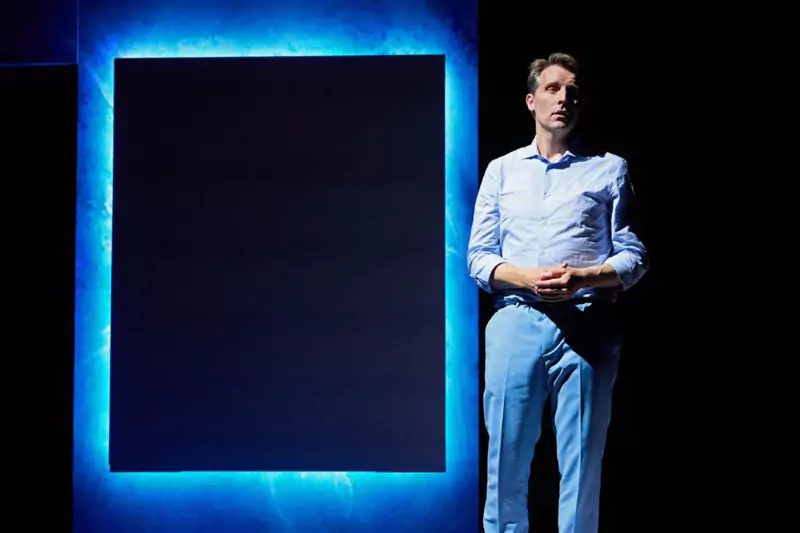
Chris Harper as Serge.
Photo credit: Geraint Lewis.
Extended arguments abound in Reza’s plays – I’m thinking also of God of Carnage. In her (characteristically tetchy) interviews, the writer has said that she sees this piece as tragedy not comedy. Khan’s production straddles both. Most of us know the scenario. Serge (Chris Harper) is a divorced doctor who pays a fortune for a painting that is no more than a white canvas with a few smudged lines. His objective engineer friend Marc (Aden Gillett) is outraged by this prodigality, and another less successful friend Yvan (Seann Walsh) tries to act as peacemaker only to find that his malleability and fence-sitting prove an irritant.
Why does this depiction of a three-way friendship come across as unimpeachably authentic? Reza was an actor before she was a writer. She later appeared in her own play Life x 3 and acquired stagecraft early in her career. She regards drama not as a prism but a mirror that gives an accurate reflection of society.
You don’t have to suspend disbelief when watching Reza’s plays, a trait that has given rise to a ridiculous (and patronizing) view among highbrow critics that her work is therefore aimed at people who would not usually go to the theatre. Khan (himself a former actor who has played Othello and Prospero) is quick to convey the fact that the characters’ divisive reactions to the painting hint at ongoing rifts on deeper matters.
Lighting by Ciarán Bagnall (he also designs the set) is so subtle that, rightly or wrongly, I intuited I was at times inside Serge’s mind’s eye with him envisaging the canvas on loan to a gallery. The lighting also shows changes in mood and is less spare than normal. A blue filter can pick out a small element such as a bottle of gin in Serge’s apartment which has an uber-modern supranational quality. Bagnall’s design includes more furniture than is normal (characters appear from its recesses at scene changes) but the action is not cluttered and the whole endeavour is as lucid as Christopher Hampton’s translation.
The tone is (rightly) austere and there is little to distract us from the brilliance of the acting, the highpoint being Walsh’s bravura five-minute breakneck monologue in which, seemingly without taking a breath, he recounts fractured conversations with his fiancée and future in-laws about a marriage which he has sought only as refuge from loneliness. All three performers are personable as they briefly come out of the dialogue and address the audience directly about what is breaking down in front of us. It’s a little unfair to say this, but the impact of the sleek set might be even greater in a black box venue rather than Eastbourne’s red-velvet upholstery and, in part, Frank Matcham architecture.
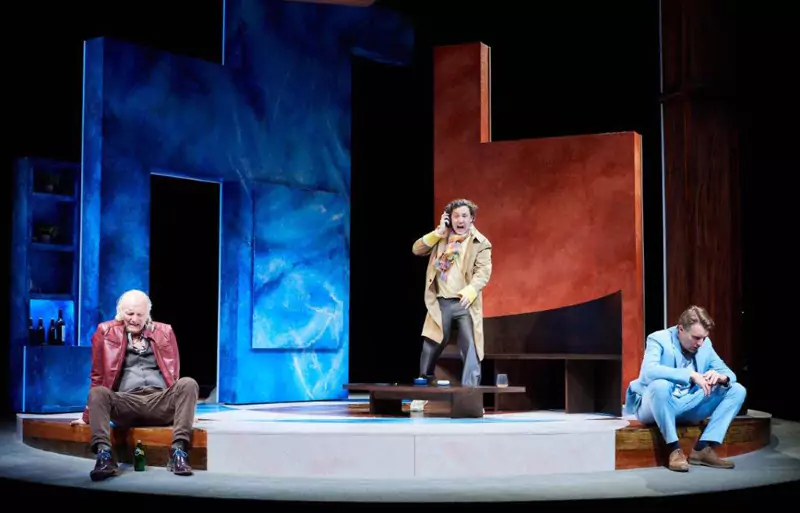
Set and lighting by Ciarán Bagnall.
Photo credit: Geraint Lewis.
Every pause (never mannered) has a significance, and Khan’s direction maintains a brittle atmosphere despite the laughter. I agree with the majority that the piece is predominantly about friendship, but it really does concern artistic taste as well, and Gillett convinces when his character dismisses the modernist painting and raves about Flemish Old Masters.
The theme of male relationships under pressure is unlikely to lose its appeal anytime soon. I don’t much care for these men, but I was consistently intrigued to know what might have brought them together. The play continues to age well. I do, however, wonder what will happen when the ghastly stationery products that underachiever Yvan has to sell for his father-in-law become outdated. When an update is necessary (the play must never be allowed to become a period piece) Yvan can no doubt begin to sell Cloud space and the like.
Khan (who recently directed East Is East at the National) has a light touch with the moments of physical comedy when words run out. The famed routine in which the men flick stones from a shared bowl of olives (trying to outdo each other for volume of sound) is pulled off neatly. Harper impresses as he conveys Serge’s sheer tactile pleasure as he brings the painting down from an unseen upper floor. And I believe him when he dismisses the others as enemies of modernism.
Serge’s purchase may be a blank canvas (I love the scene in which it is defaced with a cartoon skier done with a felt tip pen) but the play certainly isn’t. It continues to throw up challenges and makes us wonder (perhaps not for very long) if new work – as opposed to the traditional landscape near Toulouse that is also in the apartment – is stale and even staid. Are there new aesthetic laws that only Serge understands?
Before admitting that the picture is almost certainly garbage, Yvan (who is a beta male compared with the others) claims he can see different colours in it. Directors have seen different shades in their versions of this play over 30 years and not all have worked. This treatment richly deserves its sadly very short UK tour. At time of writing it is at Theatre Royal, Nottingham and will then visit Belgrade Theatre, Coventry and Sheffield Theatres, Sheffield.




